A breast self-exam is a self-inspection you do on your breast to determine if there are any abnormalities like lumps and changes. Detecting any changes means it’s time to consult a doctor. In most cases, changes in the breast end up having benign causes.
However, some changes may have serious underlying causes such as breast cancer. Routine breast self-examinations are not recommended as part of breast cancer screening by the majority of medical organizations. Routine breast self-examinations are not recommended as part of breast cancer screening by the majority of medical organizations. This is because breast self-examinations have not proved to be very effective in identifying cancer or improving breast cancer survival in women and men.
Nonetheless, experts believe it is beneficial for women to be familiar with their own breasts so that they can recognize what is normal and report any changes as soon as possible.
Read more about Health
How To Do A Breast Self-Examination
- Use a mirror to examine your breasts. Observe the size and shape of each breast and nipple. Look out for any swellings, lumps, dimpling, scaly skin, and other skin abnormalities. Check for changes in the nipple, such as a sore nipple or a nipple that is pulling inward. Squeeze both nipples gently to see if any fluid comes out. If you see any of these or other breast changes, consult your healthcare provider. Carry out this examination in the following three positions;
- Place your arms at your sides and hang them down.
- Raise your hands behind your head and join them.
- With your hands on your hips, apply hard pressure. Lean slightly forward and look in the mirror at your breasts.
- Lie down and feel your breasts. Your breast tissue spreads out evenly across your chest when you lie down. This makes it easier to detect lumps and other abnormalities in your breasts. Examine each breast separately.
- Place a small pillow or towel underneath your left shoulder. Raise your left arm and place it behind your head. Put the three middle fingers of your right hand to work. Use your fingertip pads on top of your fingers to make small circles around your breast tissue. Make dime-sized, overlapping circles on your breasts and armpits with your fingertip pads. Begin by pressing lightly. Next, press firmly into the breast with medium pressure to go a little deeper into the tissue. Finally, apply hard pressure to your breasts to feel deep into them.
- Examine the entire breast region. Feel just from your ribs from the above to below the breast. Make little circles with your fingertips beginning in the centre of your armpit. Make circles in the breast area by moving your hands up and down. Proceed all the way across your breast to your breast. Examine the area between your armpit and your sternum (breastbone).
- Put your right arm behind your head and place the cushion or towel on your right shoulder. Use your left hand’s three fingertip pads. Repeat the breast self-examination on your right breast following the steps above.
Sign up to the Connect Nigeria daily newsletter
When should I make an appointment with my doctor?
- You discover any lumps or changes in your breasts
- You’re experiencing breast pain or have fluid seeping from your nipples.
- You have concerns or questions about your condition or treatment.
What is considered normal?
Many women notice lumps or changes in their breasts, which are common and occur at various times during the menstrual cycle. It’s not necessary to be alarmed if you see a change or lump in your breast. There’s no reason to panic if you see a change or lump in your breast. Breasts can have a variety of sensations in different locations. For instance, it’s normal to have a firm ridge along the bottom of each breast. As you get older, the appearance and feel of your breasts will alter. Your breasts will vary in appearance and feel as you grow older.
Got a suggestion? Contact us: [email protected]


